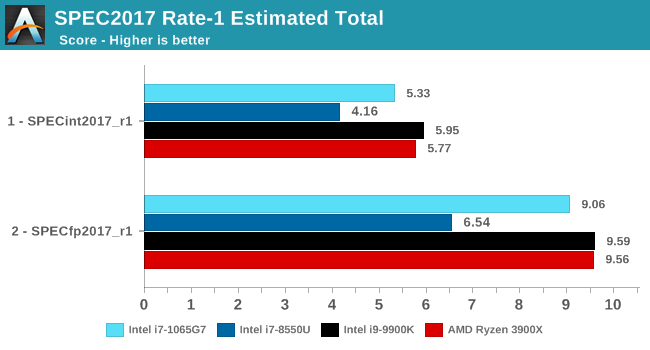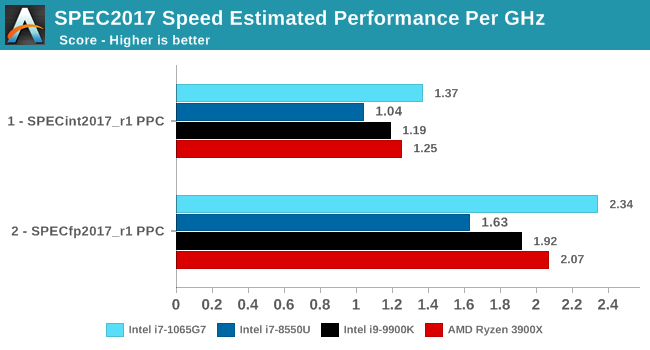The Ice Lake Benchmark Preview: Inside Intel's 10nm
by Dr. Ian Cutress on August 1, 2019 9:00 AM EST- Posted in
- CPUs
- Intel
- GPUs
- 10nm
- Core
- Ice Lake
- Cannon Lake
- Sunny Cove
- 10th Gen Core
Section by Andrei Frumusanu
SPEC2017 and SPEC2006 Results (15W)
SPEC2017 and SPEC2006 is a series of standardized tests used to probe the overall performance between different systems, different architectures, different microarchitectures, and setups. The code has to be compiled, and then the results can be submitted to an online database for comparsion. It covers a range of integer and floating point workloads, and can be very optimized for each CPU, so it is important to check how the benchmarks are being compiled and run.
We run the tests in a harness built through Windows Subsystem for Linux, developed by our own Andrei Frumusanu. WSL has some odd quirks, with one test not running due to a WSL fixed stack size, but for like-for-like testing is good enough. SPEC2006 is deprecated in favor of 2017, but remains an interesting comparison point in our data. Because our scores aren’t official submissions, as per SPEC guidelines we have to declare them as internal estimates from our part.
For compilers, we use LLVM both for C/C++ and Fortan tests, and for Fortran we’re using the Flang compiler. The rationale of using LLVM over GCC is better cross-platform comparisons to platforms that have only have LLVM support and future articles where we’ll investigate this aspect more. We’re not considering closed-sourced compilers such as MSVC or ICC.
clang version 8.0.0-svn350067-1~exp1+0~20181226174230.701~1.gbp6019f2 (trunk)
clang version 7.0.1 (ssh://git@github.com/flang-compiler/flang-driver.git
24bd54da5c41af04838bbe7b68f830840d47fc03)-Ofast -fomit-frame-pointer
-march=x86-64
-mtune=core-avx2
-mfma -mavx -mavx2
Our compiler flags are straightforward, with basic –Ofast and relevant ISA switches to allow for AVX2 instructions. Despite ICL supporting AVX-512, we have not currently implemented it, as it requires a much greater level of finesse with instruction packing. The best AVX-512 software uses hand-crafted intrinsics to provide the instructions, as per our 3PDM AVX-512 test later in the review.
For these comparisons, we will be picking out CPUs from across our dataset to provide context. Some of these might be higher power processors, it should be noted.
SPECint2006

Amongst SPECint2006, the one benchmark that really stands out beyond all the rest is the 473.astar. Here the new Sunny Cove core is showcasing some exceptional IPC gains, nearly doubling the performance over the 8550U even though it’s clocked 100MHz lower. The benchmark is extremely branch misprediction sensitive, and the only conclusion we can get to rationalise this increase is that the new branch predictors on Sunny Cove are doing an outstanding job and represent a massive improvement over Skylake.
456.hmmer and 464.h264ref are very execution bound and have the highest actual instructions per clock metrics in this suite. Here it’s very possible that Sunny Cove’s vastly increased out-of-order window is able to extract a lot more ILP out of the program and thus gain significant increases in IPC. It’s impressive that the 3.9GHz core here manages to match and outpace the 9900K’s 5GHz Skylake core.
Other benchmarks here which are limited by other µarch characteristics have various increases depending on the workload. Sunny Cove doubled L2 cache should certainly help with workloads like 403.gcc and others. However because we’re also memory latency limited on this platform the increases aren’t quite as large as we’d expect from a desktop variant of ICL.

In SPECfp2006, Sunny Cove’s wider out-of-order window can again be seen in tests such as 453.povray as the core is posting some impressive gains over the 8550U at similar clocks. 470.lbm is also instruction window as well as data store heavy – the core’s doubled store bandwidth here certainly helps it.

Overall in SPEC2006, the new i7-1065G7 beats a similarly clocked i7-8550U by a hefty 29% in the int suite and 34% in the fp suite. Of course this performance gap will be a lot smaller against 9th gen mobile H-parts at higher clocks, but these are also higher TDP products.
The 1065G7 comes quite close to the fastest desktop parts, however it’s likely it’ll need a desktop memory subsystem in order to catch up in total peak absolute performance.

Performance per clock increases on the new Sunny Cove architecture are outstandingly good. IPC increases against the mobile Skylake are 33 and 38% in the integer and fp suites, though we also have to keep in d mind these figures go beyond just the Sunny Cove architecture and also include improvements through the new LPDDR4X memory controllers.
Against a 9900K, although apples and oranges, we’re seeing 13% and 14% IPC increases. These figures likely would be higher on an eventual desktop Sunny Cove part.
SPEC2017



The SPEC2017 results look similar to the 2006 ones. Against the 8550U, we’re seeing grand performance uplifts, just shy of the best desktop processors.

Here the IPC increase also look extremely solid. In the SPECin2017 suite the Ice Lake part achieves a 14% increase over the 9900K, however we also see a very impressive 21% increase in the fp suite.
Overall in the 2017 suite, we’re seeing a 19% increase in IPC over the 9900K, which roughly matches Intel’s advertised metric of 18% IPC increase.










261 Comments
View All Comments
0ldman79 - Friday, August 2, 2019 - link
Uh...They reworked the entire 10nm process to get it going.
This isn't impossible, it is expensive and time consuming.
They've spent the $$$ and at least a year working on it.
It is hardly unheard of that the single most successful tech company on the planet figured out a problem.
yeeeeman - Wednesday, June 17, 2020 - link
This is not a reasonable argument that he gave you. He just wanted, like a lot of people today, to show his hate for Intel. He's not seeing things straight anymore and I really don't understand this hate speech that many people have today about certain products. It is what it is, reviewers test them and there is not much else to say. I guess the reason is more people are being stupid these days.dguy6789 - Thursday, August 1, 2019 - link
Stop whining. The article is well written and provides plenty of information on Intel's new chip. Nobody gives a hoot about your tinfoil hat nonsense.close - Tuesday, August 6, 2019 - link
@dguy6789, obviously plenty of people do. AT did somehow manage to bungle repeatedly, always in positive ways for Intel, not so positive for the competition.And as these things go, if it turns out AT's current article is spot on then not much will change (past mistakes were still made). But if it turns out they were played *again* (assuming ignorance not bad intentions) and AT offers the same anemic retraction then it's going to be pretty clear where the editorial team stands.
AshlayW - Thursday, August 1, 2019 - link
You can't please everyone lol. I thought the article was great, informative and, imo, fair. Interesting to get a first look at the architecture and I enjoy reading your assessments on the results, puts it into context for me. :)I'm a pretty hardcore Ryzen fan too :P
MDD1963 - Friday, August 2, 2019 - link
Yes, how *dare* anyone publish *anything* that could be read as positive about new recent Intel products' performance gains, and the sheer audacity to do so within less than a month of the Ryzen 3000 launch! :/jospoortvliet - Friday, August 2, 2019 - link
It might be an obvious marketing ploy (I agree with that assessment) and that can be pointed out but a journalist wouldn’t be doing their job any better by ignoring this opportunity... both amd and intel as well as NVIDIA play these games all the time.brakdoo - Thursday, August 1, 2019 - link
Yeah Intel is trying to give journalists more info than the public for the past few months/quarters so that these people think they are special because they are "insiders" (they don't have much else to be proud of).These journalists talked so much about IPC over these months but it turned out to be just BS because IPC is nothing without frequency (to a certain extent AMD did the same stupid IPC thing). It is obvious that the frequency issue is not just about 10 nm but instead it's caused by this messed up architecture. Otherwise Intel would just sell 14 nm Ice lake CPUs...
They even fooled these tech sites with the graphics performance. It's barely faster than Iris plus 655.
AMD had a bad history of weird journalist events and giving too much NDA info but Intel turned it into a real shitshow.
Gondalf - Thursday, August 1, 2019 - link
Likely you have some problems with Sunny Cove that is clearly superior than Zen 2 even without fast desktop DRAM and without an insane amount of L3.Pretty certain you are trying to realize how fast will be Ice Lake EP in server space.
The end of a dream??? Yes it is.
Obviously Intel is preparing itself to finer nodes that will not allow fast clock speeds anymore but an intersting density instead.
This review is a nice example of what will be the future Intel core performance cadence in the next two years.
Many thanks Haifa Team.
About GPU, it is pretty good because now it performs at 15W level and without an expensive eDRAM. Try to run the new GPU within 28W and you will have an idea of the advantages of the new ark vs. 9.5.
0ldman79 - Friday, August 2, 2019 - link
Brakdoo is way off in his assertions, but I believe you have rose colored glasses too.Intel got the efficient process working, not the high performance one. They still have 14nm planned out for another year at least.
It isn't just the lithography that is the problem either, Sunny Cove is a different architecture, it just might not clock as high. We'll have to wait and see how that all works out.
I do agree though, speeds are probably going to stall if not regress moving forward. It's just a lot of amps going through a tiny circuit. 14nm might have been the sweet spot to get the highest clock speeds. Smaller circuits will only get hotter carrying the same current. Unless they significantly lower power usage it is going to be a problem.
Apparently .7v is the switching point for silicon semi-conductors, below that the transistors don't switch, so to go beyond 7nm or 5nm they're very likely going to have to move to a more conductive material to lower the switching point as well as resistance (heat buildup).
Interesting times...